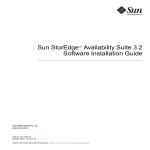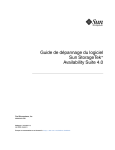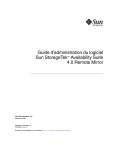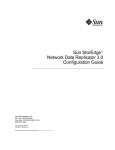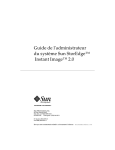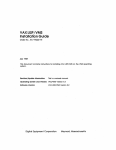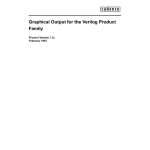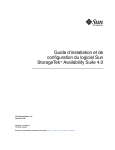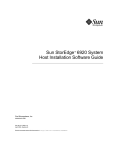Download Sun StorEdge Availability Suite 3.2 Software Release Notes
Transcript
Sun StorEdge™ Availability Suite 3.2 Software Release Notes Sun Microsystems, Inc. www.sun.com Part No. 817-2782-10 December 2003, Revision A Submit comments about this document at: http://www.sun.com/hwdocs/feedback Copyright© 2003 Sun Microsystems, Inc., 4150 Network Circle, Santa Clara, California 95054, U.S.A. All rights reserved. Sun Microsystems, Inc. has intellectual property rights relating to technology embodied in this product. In particular, and without limitation, these intellectual property rights may include one or more of the U.S. patents listed at http://www.sun.com/patents and one or more additional patents or pending patent applications in the U.S. and in other countries. This document and the product to which it pertains are distributed under licenses restricting their use, copying, distribution, and decompilation. No part of the product or of this document may be reproduced in any form by any means without prior written authorization of Sun and its licensors, if any. Third-party software, including font technology, is copyrighted and licensed from Sun suppliers. Parts of the product may be derived from Berkeley BSD systems, licensed from the University of California. UNIX is a registered trademark in the U.S. and in other countries, exclusively licensed through X/Open Company, Ltd. Sun, Sun Microsystems, the Sun logo, AnswerBook2, docs.sun.com, Sun StorEdge, and Solaris are trademarks or registered trademarks of Sun Microsystems, Inc. in the U.S. and in other countries. All SPARC trademarks are used under license and are trademarks or registered trademarks of SPARC International, Inc. in the U.S. and in other countries. Products bearing SPARC trademarks are based upon an architecture developed by Sun Microsystems, Inc. The Adobe® logo is a registered trademark of Adobe Systems,Incorporated. U.S. Government Rights—Commercial use. Government users are subject to the Sun Microsystems, Inc. standard license agreement and applicable provisions of the FAR and its supplements. Products covered by and information contained in this service manual are controlled by U.S. Export Control laws and may be subject to the export or import laws in other countries. Nuclear, missile, chemical biological weapons or nuclear maritime end uses or end users, whether direct or indirect, are strictly prohibited. Export or reexport to countries subject to U.S. embargo or to entities identified on U.S. export exclusion lists, including, but not limited to, the denied persons and specially designated nationals list is strictly prohibited. DOCUMENTATION IS PROVIDED "AS IS" AND ALL EXPRESS OR IMPLIED CONDITIONS, REPRESENTATIONS AND WARRANTIES, INCLUDING ANY IMPLIED WARRANTY OF MERCHANTABILITY, FITNESS FOR A PARTICULAR PURPOSE OR NON-INFRINGEMENT, ARE DISCLAIMED, EXCEPT TO THE EXTENT THAT SUCH DISCLAIMERS ARE HELD TO BE LEGALLY INVALID. Copyright© 2003 Sun Microsystems, Inc., 4150 Network Circle, Santa Clara, Californie 95054, Etats-Unis. Tous droits réservés. Sun Microsystems, Inc. a les droits de propriété intellectuels relatants à la technologie qui est décrit dans ce document. En particulier, et sans la limitation, ces droits de propriété intellectuels peuvent inclure un ou plus des brevets américains énumérés à http://www.sun.com/patents et un ou les brevets plus supplémentaires ou les applications de brevet en attente dans les Etats-Unis et dans les autres pays. Ce produit ou document est protégé par un copyright et distribué avec des licences qui en restreignent l’utilisation, la copie, la distribution, et la décompilation. Aucune partie de ce produit ou document ne peut être reproduite sous aucune forme, par quelque moyen que ce soit, sans l’autorisation préalable et écrite de Sun et de ses bailleurs de licence, s’il y ena. Le logiciel détenu par des tiers, et qui comprend la technologie relative aux polices de caractères, est protégé par un copyright et licencié par des fournisseurs de Sun. Des parties de ce produit pourront être dérivées des systèmes Berkeley BSD licenciés par l’Université de Californie. UNIX est une marque déposée aux Etats-Unis et dans d’autres pays et licenciée exclusivement par X/Open Company, Ltd. Sun, Sun Microsystems, le logo Sun, AnswerBook2, docs.sun.com, Sun StorEdge, et Solaris sont des marques de fabrique ou des marques déposées de Sun Microsystems, Inc. aux Etats-Unis et dans d’autres pays. Toutes les marques SPARC sont utilisées sous licence et sont des marques de fabrique ou des marques déposées de SPARC International, Inc. aux Etats-Unis et dans d’autres pays. Les produits protant les marques SPARC sont basés sur une architecture développée par Sun Microsystems, Inc. Ce produit est soumis à la législation américaine en matière de contrôle des exportations et peut être soumis à la règlementation en vigueur dans d’autres pays dans le domaine des exportations et importations. Les utilisations, ou utilisateurs finaux, pour des armes nucléaires, des missiles, des armes biologiques et chimiques ou du nucléaire maritime, directement ou indirectement, sont strictement interdites. Les exportations ou réexportations vers les pays sous embargo américain, ou vers des entités figurant sur les listes d’exclusion d’exportation américaines, y compris, mais de manière non exhaustive, la liste de personnes qui font objet d’un ordre de ne pas participer, d’une façon directe ou indirecte, aux exportations des produits ou des services qui sont régis par la législation américaine sur le contrôle des exportations et la liste de ressortissants spécifiquement désignés sont rigoureusement interdites. LA DOCUMENTATION EST FOURNIE "EN L’ÉTAT" ET TOUTES AUTRES CONDITIONS, DECLARATIONS ET GARANTIES EXPRESSES OU TACITES SONT FORMELLEMENT EXCLUES, DANS LA MESURE AUTORISEE PAR LA LOI APPLICABLE, Y COMPRIS NOTAMMENT TOUTE GARANTIE IMPLICITE RELATIVE A LA QUALITE MARCHANDE, A L’APTITUDE A UNE UTILISATION PARTICULIERE OU A L’ABSENCE DE CONTREFAÇON. Please Recycle Contents Remote Mirror Software New Features 2 Disk-based Asynchronous Queues 2 Multiple Asynchronous Flusher Threads Write Coalescing 3 Protocol Changes 3 Point-in-Time Copy Software New Features Caching of Bitmaps Only 4 4 EBS PowerSnap Integration Other New Features 3 4 4 System Requirements 5 Supported Software and Hardware In a Nonclustered Environment Supported Sun Cluster Software Known Issues and Bugs Known Issues 5 6 7 7 Shadow Volume Size Accessing Statistics 7 8 Bitmap Volume Placement 8 Rebooting Your Server Using the shutdown Command 8 Upgrading the Solaris OS with the Availability Suite 3.2 Software Installed 8 iii Creating and Configuring Sun StorEdge Volume Sets Fast Write Cache Not Supported 9 9 Configurable Maximum Number of Devices That Can be Handled by StorEdge Data Services 9 Bugs 10 Release Documentation 10 Service Contact Information iv 11 Sun StorEdge Availability Suite 3.2 Software Release Notes • December 2003 Sun StorEdge Availability Suite 3.2 Software Release Notes This document contains important information about the Sun StorEdge™ Availability Suite 3.2 software that was not available at the time the product documentation was published. Read this document so that you are aware of issues or requirements that can impact the installation and operation of the Sun StorEdge Availability Suite 3.2 software. ■ “Remote Mirror Software New Features” on page 2 ■ “Point-in-Time Copy Software New Features” on page 4 ■ “Other New Features” on page 4 ■ “System Requirements” on page 5 ■ “Known Issues and Bugs” on page 7 ■ “Release Documentation” on page 10 ■ “Service Contact Information” on page 11 1 Remote Mirror Software New Features The following features are new to the remote mirror software with the Sun StorEdge Availability Suite 3.2 software release. Disk-based Asynchronous Queues Data can be queued on disk as well as in memory. Memory-based queues are the default. Disk-based queues allow: ■ Larger local queues in asynchronous replication mode ■ Larger bursts of I/O activity without impacting application response time If a disk-based queue fills up, the remote mirror software goes to non-blocking, or scoreboarding mode. Blocking Mode Blocking mode ensures write ordering of the packets to the secondary site. It is the default mode when operating in asynchronous mode. If the asynchronous queue fills up when the software is running in blocking mode, the response time to the application can be affected adversely because the software must acknowledge each write operation before removing it from the queue. New write opertions are blocked from the queue until space is available. Non-Blocking Mode Non-blocking mode is optional in asynchronous operation. In this mode, if the asynchronous queue fills up, software discards the queue is discarded and goes into logging mode. In logging mode, the application’s write operations are not blocked, but write ordering is lost because scoreboarding keeps track of changed sectors, not the order of changes. However, the application sees no significant degradation in response time. To synchronize data on the primary and secondary sites after the filling of the queue and subsequent entry into logging mode, perform an update synchronization. 2 Sun StorEdge Availability Suite 3.2 Software Release Notes • December 2003 Multiple Asynchronous Flusher Threads The software now has the ability to use multiple flusher threads to increase the drain rate from the asynchronous queues. This allows multiple I/Os per consistency group or set on the network at one time. The default number of queue-flushing threads is two. If you prefer to use a remote mirror operation similar to the one in version 3.1, set the flusher threads to one. For enhanced performance in a low-latency network environment, increase the number of threads to greater than two. When using multiple threads, write operations often arrive at the secondary site out of sequence. To prevent any problems at the secondary site, sequence numbers are added to all data write operations at the primary site. The secondary site manages the incoming data based on the sequence numbers, essentially restoring the write order. Write operations that arrive out of order are stored in memory until previous write operations arrive. The use of multiple asynchronous flusher threads on the primary site requires more memory at the secondary site. Each set can result in a maximum of 64 pending requests in memory at the secondary site. The memory requirements for the secondary site depend on the number of groups or sets tracked, the number of requests, and the size of the write operations. When the number of requests for a group or set reaches 64, the secondary site prevents the primary site from issuing any more requests for that group or set. If memory is not available when a packet arrives, the packet is rejected and all groups and sets go into logging mode at the secondary site. Write Coalescing If possible, the remote mirror software combines, or coalesces, multiple sequential write operations to the primary volume into a single network write operation. The size of the write operations and the network packet size affect the remote mirror software’s ability to coalesce the write operations. Write coalescing provides two important advantages: ■ Improves the asynchronous queue’s drain rate ■ Improves network bandwidth utilization Protocol Changes The protocol now takes advantage of the software’s improved asynchronous flushing rate and its improved usage of network bandwidth. The protocol has been enhanced to work efficiently with the new disk-based asynchronous queues and the associated multiple flusher threads. Sun StorEdge Availability Suite 3.2 Software Release Notes 3 Point-in-Time Copy Software New Features The following features are new to the point-in-time copy software with the Sun StorEdge Availability Suite 3.2 software release. Caching of Bitmaps Only In Sun StorEdge Availability Suite 3.2 point-in-time copy software, data is no longer cached. Bitmaps are cached. To simplify the data path, the read cache is available only for bitmap volumes. The ability to use the read cache on data volumes is no longer provided. Because many disk arrays, applications, and file systems provide read and write caching, this change does not adversely affect product performance. EBS PowerSnap Integration The point-in-time copy software is now integrated with the Sun StorEdge EBS (Legato NetWorker) 7.1 PowerSnap module. Other New Features The following features are also in the Sun StorEdge Availability Suite 3.2 software: ■ 4 dsstat utility: The following commands provided in previous versions have been removed and are replaced with the /usr/opt/SUNWesm/sbin/dsstat utility: ■ /usr/opt/SUNWesm/sbin/sndrstat ■ /usr/opt/SUNWesm/sbin/scmadm -S ■ HA StoragePlus: This resource type in Sun™ Cluster 3.n environments is now supported. ■ Increased Storage Volume Limit: The default limit for storage volumes in use is increased from 1024 in the earlier versions of the software to 4096 storage volumes in the current version. To increase the number of storage volumes, see the Sun StorEdge Availability Suite 3.2 Software Installation Guide. Sun StorEdge Availability Suite 3.2 Software Release Notes • December 2003 System Requirements Supported Software and Hardware In a Nonclustered Environment TABLE 1 shows the supported software in a nonclustered environment. TABLE 2 shows the supported hardware in a nonclustered environment. If you have a SunSolveSM service subscription, patches are available at http://sunsolve.sun.com/ TABLE 1 Supported Software, Nonclustered Environments Operating Environment and Software Patches Required Solaris™ 8 Operating System (Solaris OS) None Solaris 9 OS (update 3 or higher) None Sun StorEdge Availability Suite 3.2 remote mirror software None TCP/IP network transport such as SunATM™ or Gigabit Ethernet transports None Sun StorEdge Availability Suite 3.2 point-in-time copy software None Volume manager software • Sun Solstice DiskSuite™ software • Solaris Volume Manager • VERITAS Volume Manager The Sun StorEdge software does not support metatrans devices created by using the Sun Solstice DiskSuite and Solaris Volume Manager. Sun StorEdge Availability Suite 3.2 Software Release Notes 5 TABLE 2 Hardware Supported Hardware, Nonclustered Environments A CD-ROM drive connected to the host server where the Availability Suite software is to be installed. If you plan to export shadow volumes, you must store the shadow volume on a dual-ported drive. The Sun StorEdge Availability Suite 3.2 software is supported on any Sun server or workstation that has an UltraSparc II or later processor and that is running a supported version of the Solaris OS. Hosts include but are not limited to: • Sun Enterprise™ 220R, 250, 420R, and 450 servers • Sun Enterprise 3500, 4500, 5500, 6500, and 10000 servers • Sun Fire™ 3800, 4800, 4810, and 6800 servers • Sun Fire 15K server • Sun Ultra ™ 60 and 80 workstations • Sun Blade™ 100 and 1000 workstations • Sun Netra™ t 1400/1405 and 1120/1125 servers Disk Space Allocate approximately 15 Mbytes for the installation. • The remote mirror software requires approximately 1.7 Mbytes. • The point-in-time copy software requires approximately 1.9 Mbytes. • The Sun StorEdge configuration location requires 5.5 Mbytes. • Supporting packages require approximately 5.4 Mbytes. Supported Attached Storage The remote mirror software is storage-hardware independent. Supported Sun Cluster Software The Sun StorEdge Availability Suite 3.2 software is compatible with the following versions of Sun Cluster software: ■ Sun Cluster 3.0 Update 3 ■ Sun Cluster 3.1 Note – If you are using any version of the Solaris 8 operating system with Sun Cluster 2.2, you cannot install Sun StorEdge Availability Suite 3.2 software. The products are incompatible. See the Sun Cluster 3.0/3.1 and Sun StorEdge Availability Suite 3.2 Software Integration Guide for more information. 6 Sun StorEdge Availability Suite 3.2 Software Release Notes • December 2003 Known Issues and Bugs This section discusses issues that affect how you can use the software effectively. Known Issues This section describes issues when using the Sun StorEdge Availability Suite 3.2 software. Shadow Volume Size The software returns the following error message in several circumstances when the shadow volume of a point-in-time copy volume set is not the same size as the master volume. Another package would not allow target to be changed at this moment Whenever a point-in-time copy snapshot is taken, the volume that is used to create the snapshot, the shadow volume, is made to look exactly like the master volume, including matching the number of blocks. If the master volume is larger or smaller than the shadow volume’s physical size, the shadow volume appears to be resized at the moment the snapshot is taken. Physically, the shadow volume has not changed size, but the point-in-time copy kernel module always reports its size to be the same size as the master volume. This can present several problems with the remote mirror software, which does not expect the size of the volume to change: ■ If you plan to use a remote mirror primary or secondary volume as a point-intime copy shadow volume, the master and the shadow of that volume set must be exactly the same size. If they are different, you get an error when attempting to enable the point-in-time copy volume set with the iiadm -e command. ■ You might also see this error during a disable iiadm -d command. If the shadow volume of the existing point-in-time copy volume set is not the same size as the master volume and a remote mirror volume set was enabled using that shadow volume as the primary or secondary, the point-in-time copy software stops you from performing the disable operation. Sun StorEdge Availability Suite 3.2 Software Release Notes 7 Accessing Statistics The dsstat utility is now the only source of statistics for the operation of the software. The utility, sndrstat, is no longer supported. See the Sun StorEdge Availability Suite 3.2 Administration and Operations Guide for details of the dsstat utility. Bitmap Volume Placement Due to the read-modify-write behavior of point-in-time bitmap volumes, placing many of them on a single RAID-5 volume introduces high I/O contention involving the disks associated with the RAID-5 volume. This I/O contention is noticeable at volume unmounting time, as seen when an application suite or system is being shutdown. Place bitmap volumes on RAID-1 sets, multiple RAID-5 sets, or on a cached-array disk controller. Rebooting Your Server Using the shutdown Command When you install, remove, or reinstall the software, shutdown the system and restart in single-user mode. This provides the following protection while you are working: ■ Prevents other users from getting access to data volumes ■ Prevents the volumes from unmounting automatically When you have completed these procedures, shut down and restart in multi-user mode. Caution – Do not use the reboot command. Always use the shutdown command. The shutdown command ensures that any shutdown scripts in the /etc/init.d directory are executed. Upgrading the Solaris OS with the Availability Suite 3.2 Software Installed If you installed the Sun StorEdge Availability Suite 3.2 software in one Solaris OS and now wish to upgrade to a newer release of the Solaris OS, follow this procedure: 1. Remove the Sun StorEdge Availability Suite 3.2 software. 2. Upgrade the operating environment. 3. Reinstall the Sun StorEdge Availability Suite 3.2 software. 8 Sun StorEdge Availability Suite 3.2 Software Release Notes • December 2003 Creating and Configuring Sun StorEdge Volume Sets Caution – Only one system administrator or root user at a time can create and configure Sun StorEdge shadow volume sets. This helps avoid inconsistency in the Sun StorEdge configuration. The operations that access the configuration include, but are not limited to: ■ Creating and deleting shadow volume sets ■ Adding and removing shadow volume sets from I/O groups ■ Assigning new bitmap volumes to a shadow volume set ■ Updating the disk device group or resource name ■ Any operation that changes the Sun StorEdge and related shadow volume set configuration Fast Write Cache Not Supported Fast Write Cache is no longer supported so when you use the scmadm -o command, the write hints, wrthru and nowrthru, are no longer displayed. In addition, the write hints are no longer displayed when the scmadm command is run with no arguments. Configurable Maximum Number of Devices That Can be Handled by StorEdge Data Services In this release, the default limit of sv-enabled devices has increased to 4096 devices from the default limit of 1024 devices in the Availability Suite 3.1 release. If you are using VERITAS Volume Manager volumes and you have more than approximately 2250 volumes in any one disk group, the VERITAS Volume Manager might be unable to start the volumes after a reboot and then report that the configuration request is too large. If the VERITAS volumes fail to start, the Availability Suite software is also unable to resume the devices. Resolve this problem by adding a second volume manager disk group and by dividing the volumes between the two disk groups. For additional information, see the Sun Cluster 3.0/3.1 and Sun StorEdge Availability Suite 3.2 Software Integration Guide, and the Sun Cluster 3.0/3.1 and Sun StorEdge Availability Suite 3.2 Software Release Note Supplement. Sun StorEdge Availability Suite 3.2 Software Release Notes 9 Bugs ■ 4930424: The software allows you to specify a disk queue of greater than 1 TB although this creates an error condition. Work around: None. Do not specify a disk queue larger than the maximum size, 1 TB. ■ 4942385: Long volume names cause warning messages to be cut off due to a buffer limitation. If you are using long volume names, some errors may be cut off early. ■ 4942997: sndr: sndradm unknown host: vol printed in ds.log diskq operations are printing “unknown” when logging to ds.log. ■ 4943430: Availability Suite 3.2 TNF racing panics a Solaris 8 system. Sun StorEdge Availability Suite 3.2 TNF tracing on any system running these operating environments cause the system to panic: ■ ■ Solaris 8, FCS initial release Solaris 8, 10/00 release (also known as Update 1) Work around: Do not initiate TNF tracing with the prex -k command on any system running an operating environment prior to Solaris 8, Update. ■ 4943317: Availability Suite 3.2 on a Solaris 8 system outputs unnecessary error message during shut down. Executing /etc/shutdown on a system running Solaris 8 and Sun StorEdge Availability Suite 3.2 causes the following message to be displayed on the console: scmadm: cache has been deconfigured Cannot stop nskernd: 2 kernel threads still running As the Solaris 8 system is shutting down, this irrelevant message will be displayed. the nskernd daemon will be stopped successfully and will not prevent a clean system shut down. Release Documentation The product documentation is located on the product CD in Adobe® Acrobat (PDF) format. To get access to this documentation: 1. Change to the root user. 2. Insert the product CD into the CD-ROM drive that is connected to your system. 10 Sun StorEdge Availability Suite 3.2 Software Release Notes • December 2003 3. If the Volume Manager daemon vold(1M) is not started, use the following command to start it. This allows the CD to automount the /cdrom directory. # /etc/init.d/volmgt start 4. Change to the Docs directory. # cd /cdrom/cdrom0/Docs From this location, you can view the documentation using the free Adobe Acrobat Reader software. If you do not have the Adobe Acrobat Reader software, this CD provides it in the /cdrom/cdrom0/Acro_Read directory. Install this to your local machine. The software is also available from Adobe Systems at www.adobe.com. Service Contact Information If you need help installing or using this product, call 1-800-USA-4SUN, or go to: http://www.sun.com/service/contacting/index.html Sun StorEdge Availability Suite 3.2 Software Release Notes 11 12 Sun StorEdge Availability Suite 3.2 Software Release Notes • December 2003
















